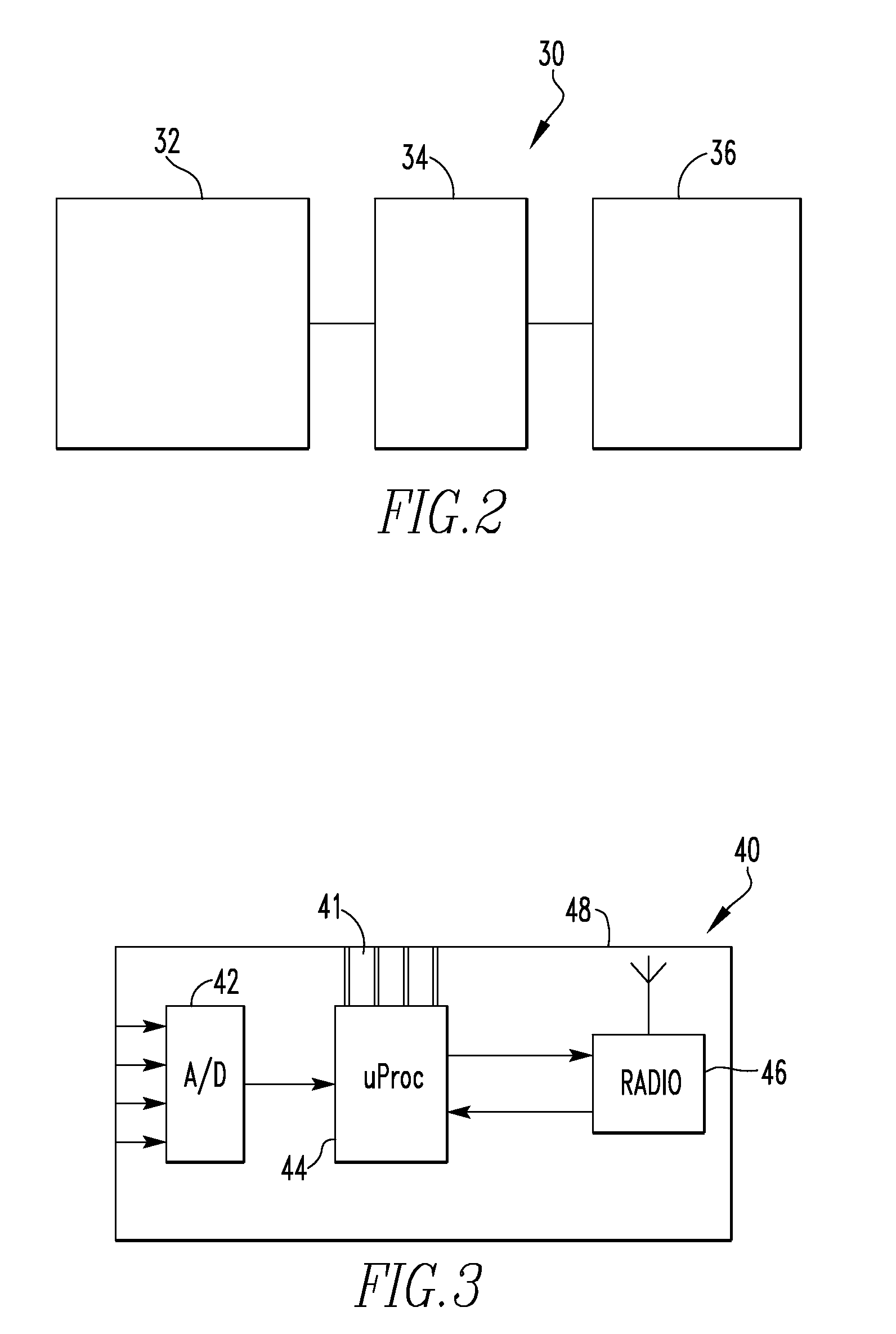System and method for communicating with an implant
a technology for implant communication and implants, applied in the field of orthopaedic implants, can solve the problems of increased risk to the health of patients, insufficient diagnosis of x-rays, and inability to accurately diagnose, etc., and achieve the effect of high permeable material and stable reading
- Summary
- Abstract
- Description
- Claims
- Application Information
AI Technical Summary
Benefits of technology
Problems solved by technology
Method used
Image
Examples
first embodiment
[0056]FIG. 1 illustrates a system 10 for communicating with an implant in a The system 10 includes an orthopaedic implant 12, a coil 14, a signal generator 15, an amplifier 16, a data packet 18, a processor 20, and a receiver 22. In the depicted embodiment, the orthopaedic implant is an intramedullary nail but other types of orthopaedic implants may equally be used. As examples, the orthopaedic implant may be an intramedullary nail, a bone plate, a hip prosthetic, or a knee prosthetic. Further, the processor 20 is depicted as a desktop computer in FIG. 1 but other types of computing devices may equally be used. As examples, the processor 20 may be a desktop computer, a laptop computer, a personal data assistant (PDA), mobile handheld device, or a dedicated device. In some embodiments, the processor 20 and the receiver 22 form a single component. In the depicted embodiment, however, the receiver 22 is electrically connected to the processor 20 but is a separate component. As example...
second embodiment
[0067]FIG. 10 schematically illustrates on-board implant electronics 80. In FIG. 10, some components, such as a power supply, have been removed for clarity. The on-board implant electronics 80 includes a plurality of sensor and wheatstone bridge assemblies 82, a multiplexer 83, an amplifier 84, a microprocessor 86, and a transmitter 88. In its simplest form, the multiplexer 83 is an addressable switch. The multiplexer 83 is linked to the microprocessor and selects the sensor from which to receive data. In the depicted embodiment, the sensor assembly 82 includes a foil gauge connected to a wheatstone bridge. Alternatively, the sensor may be a semiconductor strain gauge. The microprocessor 86 includes an analog-to-digital converter that converts the analog signal from the sensor assembly to a digital signal. When the sensor assemblies 82 are powered, each sensor assembly 82 sends a signal to the multiplexer 83. The multiplexer 83 sends the multiplexed signal to the amplifier 84, which...
third embodiment
[0076]FIG. 26 illustrates a system 310 for communicating with an implant in a The system 310 includes an orthopaedic implant 312, a paddle 314, a data packet 318, a first processor 320, and a control unit 322. In the depicted embodiment, the orthopaedic implant 312 is an intramedullary nail but other types of orthopaedic implants may equally be used. As examples, the orthopaedic implant 312 may be an intramedullary nail, a bone plate, a hip prosthetic, or a knee prosthetic. Further, the first processor 320 may be a desktop computer, a laptop computer, a personal data assistant (PDA), mobile handheld device, or a dedicated device. In some embodiments, the first processor 320 and the control unit 322 form a single component. In the depicted embodiment, however, the control unit 322 is electrically connected to the processor 320 but is a separate component. Optionally, the system 310 also may include a feedback indicator 324, a load scale 326, a portable storage device 328, and / or a s...
PUM
 Login to View More
Login to View More Abstract
Description
Claims
Application Information
 Login to View More
Login to View More - R&D
- Intellectual Property
- Life Sciences
- Materials
- Tech Scout
- Unparalleled Data Quality
- Higher Quality Content
- 60% Fewer Hallucinations
Browse by: Latest US Patents, China's latest patents, Technical Efficacy Thesaurus, Application Domain, Technology Topic, Popular Technical Reports.
© 2025 PatSnap. All rights reserved.Legal|Privacy policy|Modern Slavery Act Transparency Statement|Sitemap|About US| Contact US: help@patsnap.com



